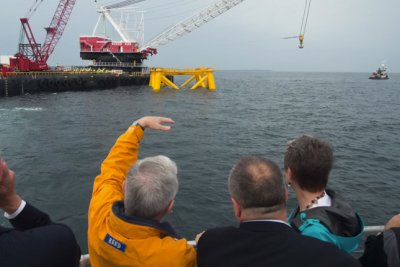
Offshore wind farm company Orsted, which was working on a wind farm off the coast of Rhode Island, announced Thursday it is reducing the size of its global work force as construction activity slows in the next two years. Pictured, construction on Orsted’s wind farm off Block Island, RI, starts in 2015. File Photo by Department of the Interior/UPI
Oct. 9 (UPI) — The offshore wind farm company Orsted announced Thursday it plans to cut its workforce by roughly one-quarter by the end of 2027 as it redirects its business toward Europe and Asia.
Orsted said Thursday that as a number of offshore wind farms are finalized and come online in the next few years it needs to right size its workforce to match a decline in construction activities it expects to see.
“This is a necessary consequence of our decision to focus our business and the fact that we’ll be finalizing our large construction portfolio in the coming years — which is why we’ll need fewer employees,” Rasmus Errboe, CEO of Orsted, said in a press release.
“At the same time, we want to create a more efficient and flexible organization and a more competitive Orsted, ready to bid on new value-accretive offshore wind projects,” Errboe said.
Right now, the company employs roughly 8,000 people globally but as it wraps up current construction work and some employees become redundant, on top of natural attrition and other moves, Orsted plans to reduce its head count to roughly 6,000.
The company has spent the year updating its portfolio, it said, as its roughly 8.1 gigawatt construction portfolio starts to come online, with most of its geographic and technical focus to be aimed at Europe, as well as some markets in the Asia-Pacific region.
In the United States, Orsted was ordered by the Trump administration in August to stop construction its nearly completed Revolution Wind project off the coast of New England.
The stop work order was part of a Trump move to cut nearly $700 million in funding from 12 wind farms because it considered the projects to be “wasteful.”
Revolution Wind, at the time, was roughly 80 percent complete and expected to provide enough power for more than 350,000 homes in Rhode Island and Connecticut.
“We’re building a more financially robust and competitive company with solid earnings, which will increase as we complete our projects,” Errboe said in the release. “Once we’ve achieved this, Orsted will be a significantly stronger, more focused and competitive company.”
On the news, shares for the company were trading 0.7 percent higher on Thursday, according to CNBC.